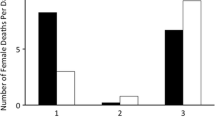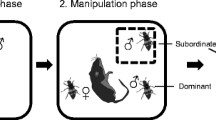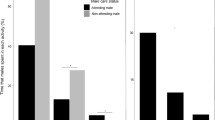Summary
Male giant waterbugs (Belostoma flumineum Say) brood eggs oviposited on their dorsa by conspecific females. Laboratory observations indicate that viable egg pads are occasionally discarded before hatching. Theory predicts that such behavior should occur only if the costs incurred by brooding exceed the benefits of hatching the egg pad. We studied the effects of egg pad size, time invested in brooding, and egg viability upon the continuation of paternal care in the giant waterbug. We found that smaller egg pads are less likely to hatch than larger ones, and males appear to be less likely to discard egg pads as temporal investment increases. However, the inviability of eggs did not appear to affect the probability of an egg pad being discarded. Males of this species appear to have evolved a decision-making process involving the continuation of paternal care.
Similar content being viewed by others
References
Andersson M, Wiklund C, Rundgren H (1980) Parental defence of offspring: a model and an example. Anim Behav 28:536–542
Armstrong T, Robertson RJ (1988) Parental investment based on clutch value: nest desertion in response to partial clutch loss in dabbling ducks. Anim Behav 36:941–943
Biermann GC, Robertson RJ (1981) An increase in parental investment during the breeding season. Anim Behav 29:487–489
Biermann GC, Robertson RJ (1983) Residual reproductive value and parental investment. Anim Behav 31:311–312
Blancher PJ, Robertson RJ (1982) Kingbird aggression: does it deter predation? Anim Behav 30:929–930
Boucher DH (1977) On wasting parental investment. Am Nat 111:786–788
Carlisle TR (1982) Brood success in variable environments: implications for parental care allocation. Anim Behav 30:824–836
Carlisle TR (1985) Parental response to brood size in a cichlid fish. Anim Behav 33:234–238
Clutton-Brock TH (1991) The evolution of parental care. Princeton University Press, Princeton
Coleman RM, Gross MR, Sargent RC (1985) Parental investment decision rules: a test in bluegill sunfish. Behav Ecol Sociobiol 18:59–66
Colgan PW, Gross MR (1977) Dynamics of aggression in male pumpkinseed sunfish (Lepomis gibbosus) over the reproductive phase. Z Tierpsychol 43:139–151
Cullen MJ (1969) The biology of giant water bugs (Hemiptera: Belostomatidae) in Trinidad. Proc R Entomol Soc Lond (A) 44:123–136
Curio E (1988) Relative realized life span and delayed cost of parental care. Am Nat 131:825–836
Curio E, Regelmann K (1987) Do great tit Parus major parents gear their brood defence to the quality of their young? Ibis 129:344–352
Curio E, Regelmann K, Zimmermann U (1984) The defence of first and second broods by great tit (Parus major) parents: a test of predictive sociobiology. Z Tierpsychol 66:101–127
Dawkins R (1976) The selfish gene. Oxford University Press, New York
Dawkins R, Carlisle TR (1976) Parental investment, mate desertion and a fallacy. Nature 262:131–133
East M (1981) Alarm calling and parental investment in the robin, Erithacus rubecula. Ibis 123:223–230
Fagerström T (1982) Maternal investment, female rivalry, and a fallacy. Oikos 39:116–118
Greig-Smith PW (1980) Parental investment in nest defence by stonechats (Saxicola torquata). Anim Behav 28:604–619
Kopelke J (1980) Morphologische und biologische Studien an Belostomatiden am Beispiel der mittelamerikanischen Arten Belostoma ellipticum und B. thomasi (Heteroptera). Ent Abh Mus Tierk Dresden 44:59–80
Kraus WF, Gonzales MJ, Vehrencamp SL (1989) Egg development and an evaluation of some of the costs and benefits for paternal care in the belostomatid, Abedus indentatus (Heteroptera: Belostomatidae). J Kans Entomol Soc 62:548–562
Kruse KC (1990) Male backspace availability in the giant waterbug (Belostoma flumineum Say). Behav Ecol Sociobiol 26:281–289
Lauck DR, Menke AS (1961) The higher classification of the Belostomatidae (Hemiptera). Ann Entomol Soc Am 54:644–657
Maynard Smith J (1977) Parental investment: a prospective analysis. Anim Behav 25:1–9
Mock DW, Parker GA (1986) Advantages and disadvantages of egret and heron brood reduction. Evolution 40:459–470
Montgomerie RD, Weatherhead PJ (1988) Risks and rewards of nest defence by parent birds. Q Rev Biol 63:167–187
Pianka ER (1976) Natural selection of optimal reproductive tactics. Am Zool 16:775–784
Pressley PH (1981) Parental effort and the evolution of nest-guarding tactics in the threespine stickleback, Gasterosteus aculeatus L. Evolution 35:282–295
Redondo T, Carranza J (1989) Offspring reproductive value and nest defense in the magpie (Pica pica). Behav Ecol Sociobiol 25:369–378
Reid MC, Montgomerie RD (1985) Seasonal patterns of nest defence by Baird's sandpipers. Can J Zool 63:2207–2211
Ricklefs RE (1969) An analysis of nesting mortality in birds. Smithson Contrib Zool 9:1–48
Ricklefs RE (1977) On the evolution of reproductive strategies in birds: reproductive effort. Am Nat 111:453–478
Sargent RC, Gross MR (1985) Parental investment decision rules and the Concorde fallacy. Behav Ecol Sociobiol 17:43–45
Sargent RC, Gross MR (1986) Williams' principle: an explanation of parental care in teleost fishes. In: Pitcher TJ (ed) The behaviour of teleost fishes. Croom Helm, London, pp 275–293
Schaffer NM (1974a) Selection for optimal life histories: the effects of age structure. Ecology 55:291–303
Schaffer NM (1974b) Optimal reproductive effort in fluctuating environments. Am Nat 108:783–790
Smith RL (1974) Life history of Abedus herberti in central Arizona (Hemiptera: Belostomatidae). Psyche 81:272–283
Smith RL (1976) Brooding behavior of a male water bug Belostoma flumineum (Hemiptera: Belostomatidae). J Kans Entomol Soc 49:333–343
Smith RL (1979a) Repeated copulation and sperm precedence: paternity assurance for a male brooding water bug. Science 205:1029–1031
Smith RL (1979b) Paternity assurance and altered roles in the mating behaviour of a giant water bug, Abedus herberti (Heteroptera: Belostomatidae). Anim Behav 27:716–725
Tait DEN (1980) Abandonment as a reproductive tactic — the example of grizzly bears. Am Nat 115:800–808
Tallamy DW (1982) Age specific maternal defense in Gargaphia solani (Hemiptera: Tingidae). Behav Ecol Sociobiol 11:7–11
Tallamy DW (1984) Insect parental care. Bioscience 34:20–24
Torre Bueno JR de la (1906) Life histories of North American water bugs. I. Life history of Belostoma flumineum Say. Can Entomol 38:189–197
Trivers RL (1972) Parental investment and sexual selection. In: Campbell B (ed) Sexual selection and the descent of man 1871–1971. Aldine Press, Chicago, pp 136–179
Usinger RL (1956) Aquatic Hemiptera. In: Usinger RL (ed) Aquatic insects of California. University of California Press, Berkeley, pp 182–228
Walters JR (1982) Parental behavior in lapwings (Charadriidae) and its relationships with clutch sizes and mating systems. Evolution 36:1030–1040
Weatherhead PJ (1979) Do savannah sparrows commit the Concorde fallacy? Behav Ecol Sociobiol 5:373–381
Westmoreland D (1989) Offspring age and nest defence in mourning doves: a test of two hypotheses. Anim Behav 38:1062–1066
Williams GC (1966a) Natural selection, the costs of reproduction, and a refinement of Lack's principle. Am Nat 100:687–690
Williams GC (1966b) Adaptation and natural selection. Princeton University Press, Princeton
Winkler DW (1987) A general model for parental care. Am Nat 130:526–543
Wittenberger JF (1981) Animal social behavior. Duxbury Press, Boston
Zar JH (1984) Biostatistical analysis. Prentice-Hall, Englewood Cliffs
Author information
Authors and Affiliations
Additional information
Offprint requests to: K.C. Kruse
Rights and permissions
About this article
Cite this article
Kight, S.L., Kruse, K.C. Factors affecting the allocation of paternal care in waterbugs (Belostoma flumineum Say). Behav Ecol Sociobiol 30, 409–414 (1992). https://doi.org/10.1007/BF00176176
Received:
Accepted:
Issue Date:
DOI: https://doi.org/10.1007/BF00176176




